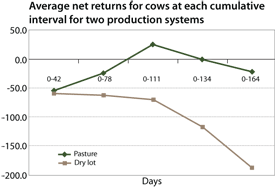Cull cows represent between 15 and 30 percent of a cow-calf herd's revenue, but relatively little attention is given to cull cow marketing. Most cow-calf producers traditionally sort and sell cull cows in the fall when prices are at or near the seasonal low. However, alternative management systems and timing of cull cow marketing may increase net revenues for the cow-calf operation. The purpose of this article is to report the first year's findings of a three-year cull cow management study conducted at the Noble Foundation in collaboration with the Department of Agricultural Economics at Oklahoma State University.
A total of 48 cull cows were randomly assigned to one of two cull cow management systems, including 1) feeding 24 cull cows on grain and supplement in dry lot confinement and 2) a system that allowed 24 cull cows to graze native forage pasture. The experiment was conducted from October 2007 to April 2008. Various data measurements were taken at five intervals including the initial culling date (Oct. 3). Time periods after culling were 42 days (Nov. 15), 78 days (Jan. 10), 111 days (Feb. 12), 134 days (March 6) and 164 days (April 2). Data were collected on weight, estimated USDA grade, estimated dressing percentage, costs (feed, animal health, etc.) and estimated market value. For each feeding time interval and each cumulative period, estimated animal performance and net returns were calculated. Estimated USDA grade and dressing percentage were used to assign a price to each cow, based on prices reported by the Agricultural Marketing Service (AMS) for cull cows in Oklahoma sold the same week. The market value of each cow at each period was calculated. Data enabled tracking animal performance, costs and estimated value, all of which are critical to assessing the added costs and returns for retaining cows beyond the normal culling date.
Average daily gain (ADG) declined generally for each group of cows. ADG was higher for cows in dry lot after 42 days (November) and remained higher for each cumulative feeding interval. For both management systems, the decline in ADG indicated weight gain was slowing as the length of the feeding period increased.
Average cost of gain was lower for cows on grass compared with cows in dry lot. Cows in dry lot gained faster, but ration costs were much higher, thereby contributing to the higher cost per gain. Feed costs accounted for 83 to 93 percent of total costs for each feeding interval. Percentages were higher for cows in dry lot than cows on grass.
For all intervals, net returns were greater for cows on grass than cows in dry lot. Cows gained in value during the first 42 days (October to November) from added weight, but declined in value over that 42-day period from the drop in prices. After the first interval, price increases offset losses in value from weight loss for cows on grass. Cows in dry lot increased in value both from additional weight gain and increase in prices. However, net returns for cows in dry lot declined due to the higher feed costs associated with obtaining the weight gain.
Cows on grass lost weight after the first 42 days (October to November), reducing their value. However, their ration costs were low, so even at lower weights, their value increased due to higher prices. The higher prices and lower costs compensated for the loss in weight.
Figure 1 below indicates that only at 111 days (February) and 134 days (March) were net returns positive for either feeding program for this first year of a three-year experimental design. In this first year, the best alternative would have been to keep cows on native grass and market them at 111 days (February).
Results suggest a potential for holding cows beyond culling for about three months on a low-cost feeding program. However, results indicate the key to net returns in this first year of the experiment was experiencing the typical seasonal price increase from the low in November through the January-February period.

by Jon Biermacher and Billy Cook
Source : Noble Foundation